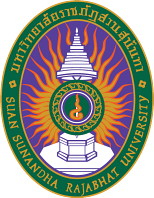การเพิ่มประสิทธิภาพของมอเตอร์กระแสตรงแบบไร้แปรงถ่าน สำหรับกังหันน้ำพลังงานแสงอาทิตย์ด้วยวงจรติดตามกำลังไฟฟ้าสูงสุด
คำสำคัญ:
มอเตอร์กระแสตรงแบบไร้แปรงถ่าน, ประสิทธิภาพเซลล์แสงอาทิตย์, การติดตามกำลังไฟฟ้าสูงสุดบทคัดย่อ
บทความนี้ศึกษาการเพิ่มประสิทธิภาพมอเตอร์กระแสตรงไร้แปรงถ่านสำหรับกังหันน้ำพลังงานเซลล์แสงอาทิตย์ โดยการเลือกใช้วงจรอินเวอร์เตอร์เป็นอุปกรณ์ที่ใช้ในการติดตามกำลังไฟฟ้าสูงสุดของเซลล์แสงอาทิตย์ ทำการทดลองต่อเซลล์แสงอาทิตย์ 1 แผง ขนาด 36 V กำลัง 260 W ผ่านชุดติดตามกำลังไฟฟ้าสูงสุดของเซลล์แสงอาทิตย์และต่อเข้ากับมอเตอร์ไฟฟ้ากระแสตรงแบบไร้แปรงถ่าน โดยผลการทดลอง สรุปได้ว่า ในสภาวะปกติของกังหันน้ำพลังงานเซลล์แสงอาทิตย์ทั่วไปที่ไม่ได้ใช้วงจรติดตามกำลังไฟฟ้าสูงสุด ผลิตกำลังไฟฟ้าเฉลี่ย 49.5 W แต่เมื่อได้มีการติดตั้งวงจรติดตามกำลังไฟฟ้าสูงสุดแล้วทำการวัดค่ากำลังไฟฟ้า ได้ค่ากำลังไฟฟ้าเฉลี่ย 137.7 W จะเห็นได้ว่าเมื่อมีวงจรติดตามกำลังไฟฟ้าสูงสุด ได้กำลังไฟฟ้าเพิ่มมากว่าถึง 88.2 W หรือมีประสิทธิภาพเพิ่มขึ้น 2.78 เท่า ซึ่งจากการติดตามกำลังไฟฟ้าสูงสุดโดยใช้วงจรที่ถูกพัฒนาทำให้ได้ประสิทธิภาพที่สูงขึ้น และยังสามารถติดตามกำลังไฟฟ้าสูงสุดได้ตลอดช่วงระยะเวลาที่เซลล์แสงอาทิตย์สามารถผลิตไฟฟ้าได้ที่ความเข้มของแสงอาทิตย์ที่ค่าต่างกัน ไม่ว่าจะมีเงาของเมฆหรือไม่มีก็ตาม ยังคงสามารถทำงานได้ดี
References
[2] Serm Janjai. (2017). Solar Radiation. (2). Nakhon Pathom: Petchkasem Printing Group Company Limited.
[3] Promphak Boonraksa. (2019). The Power Output Forecasting on Photovoltaic Systems using the Particle Swarm Optimization - Artificial Neural Network Method. A Thesis Submitted in Partial Fulfillment of the Requirement for the Degree of Doctor of Electrical Engineering. King Mongkut’s institute of Technology Ladkrabang, Thailand.
[4] Department of Alternative Energy Development and Efficiency. (2018). Thailand Alternative Energy Situation 2018. Vol. 16 (No.16), Page 27. Bangkok: Ministry of Energy.
[5] Weerachet khunngern and Wuttipol Tarateraset. (2014). Power Electronices (3). Bangkok: v-j-printing-limited-partnership.
[6] Teywin Nilsakorn. (2014). Improving drive system efficiency for brushless DC electric motors. Thesis Master of Electrical Engineering. King Mongkut’s institute of Technology Ladkrabang, Thailand.
[7] Taywin nilsakron. Promphak Dawan. (2016). A Study of the Effect of BLDC Motor Operation and ASD Adjusted by Various Position of Hall Effect Sensors. Wichcha journal Nakhon Si Thammarat Rajabhat University, Vol. 35 (No.), pp. 79 – 91.
[8] Promphak Boonraksa, and Terapong Boonraksa, “Comparison of Performance Cuk, SEPIC converters and PSO Algorithm for MPPT on Solar Panel,” in the eighth national symposium and the fourth international symposium "Research and Innovation for the Development of Society toward Sustainability" Conference Program, Bangkokthonburi University, 2020, pp. 76-85.
[9] Promphak Boonraksa, Tanakorn Thongpan, Monthicha Datraweeroj Sutanee Aimarom and Terapong Boonraksa, “A Study of Cuk Converter for Maximum Power Point Tracker on 80 W Mono-Crystalline Solar Panel,” in the eighth national symposium and the fourth international symposium "Research and Innovation for the Development of Society toward Sustainability" Conference Program, Bangkokthonburi University, 2020, pp. 86-96.
[10] Maximum power point tracking. (2017). Power Electronics and Control Techniques for Maximum Energy Harvesting in Photovoltaic Systems, 35–87. https://doi.org/10.1201/b14303-2
[11] Promphak Boonraksa, Channarong Salakham, Satawat Phumpakwan, “Performance of Maximum Power Point Tracking Using SEPIC Converter,” in the eighth national symposium and the fourth international symposium "Research and Innovation for the Development of Society toward Sustainability" Conference Program, Bangkokthonburi University, 2020, pp. 97-108.
[12] Dawan, P., Worranetsuttikul, K., Kittisontirak, S., Sriprapha, K., and Titiroongruang, W. (2018). Performance of the Temperature Model in Forecasting the Power Output of Photovoltaic Systems. International Electrical Engineering Congress, Vol 1, pp. 209- 211.
[13] Yousry Atia, (2014). Photovoltaic maximum power point tracking using sepic converter. ERJ. Engineering Research Journal, Vol 32(4), pp. 437-445. doi:10.21608/erjm.2009.69528
[14] Tawin Nilsakhon. (2014). Efficiency improvement on brushless DC motor drive systems. Thesis Master of Electrical Engineering. King Mongkut’s institute of Technology Ladkrabang ,Thailand.
[15] Yi-Hwa Liu, Shyh-Ching Huang, Jia-Wei Huang and Wen-Cheng Liang.(2012). A Particle Swarm Optimization-Based Maximum Power Point Tracking Algorithm for PV Systems Operating Under Partially Shaded Conditions. IEEE Transactions on Energy Conversion, Vol 27, Issue: 4.
[16] Poom Konghuayrob. (2013). A study on multiple step size incremental conductance technique and fuzzy logic control for MPPT in flyback PV inverter. Thesis Master of Electrical Engineering. King Mongkut’s institute of Technology Ladkrabang, Thailand.
[17] Kritapas Phinsantia. (2014). Design Technique of brushless DC motor control with Sensorless Back EMF Zero Crossing Detection. Thesis Master of Electrical Engineering. King Mongkut’s institute of Technology Ladkrabang, Thailand.
Downloads
เผยแพร่แล้ว
How to Cite
ฉบับ
บท
License
บทความที่ได้รับการตีพิมพ์เป็นลิขสิทธิ์ของคณะวิศวกรรมศาสตร์และเทคโนโลยีอุตสาหกรรม มหาวิทยาลัยราชภัฎสวนสุนันทา
ข้อความที่ปรากฏในบทความแต่ละเรื่องในวารสารวิชาการเล่มนี้เป็นความคิดเห็นส่วนตัวของผู้เขียนแต่ละท่านไม่เกี่ยวข้องกับมหาวิทยาลัยราชภัฎสวนสุนันทา และคณาจารย์ท่านอื่นๆในมหาวิทยาลัยฯ แต่อย่างใด ความรับผิดชอบองค์ประกอบทั้งหมดของบทความแต่ละเรื่องเป็นของผู้เขียนแต่ละท่าน หากมีความผิดพลาดใดๆ ผู้เขียนแต่ละท่านจะรับผิดชอบบทความของตนเองแต่ผู้เดียว







